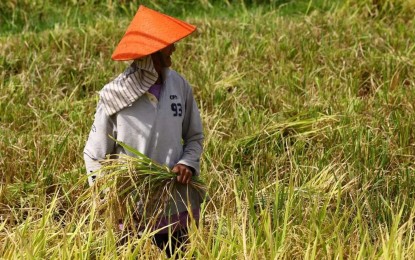MANILA – Rice farmers earned more in 2024 despite rising production costs, while the country also achieved a stronger rice buffer stock, according to the Department of Agriculture (DA).
Data from the Philippine Statistics Authority (PSA) shows that the average farmgate price per kilogram of palay (unhusked rice) increased to PHP23.48 in 2024, up from PHP19.88 in 2023.
This led to a higher gross return of PHP95,906 per hectare and a net return of PHP36,211 per hectare, compared to PHP82,914 and PHP26,423, respectively, in 2023.
The net profit-cost ratio reached PHP0.61 for every kilogram of palay sold, higher than PHP0.47 in 2023 and PHP0.20 in 2022.
The National Food Authority’s (NFA) Price Range Scheme (PRICERS) helped influence traders’ pricing last year.
« Despite lower production due to El Niño, La Niña, and successive typhoons, farmers still benefited from favorable pricing, » a DA spokesperson stated.
The NFA Council increased the buying price for dry and clean palay to between PHP23 and PHP30 per kilogram, while fresh and wet palay prices ranged from PHP17 to PHP23.
Previously, NFA’s buying price was set at PHP16 to PHP19 per kilogram for wet palay and PHP19 to PHP23 for dry palay.
Farmers’ income outpaced rising production costs, which were mainly driven by higher labor expenses.
The PSA reported that the average production cost for palay rose to PHP14.52 per kilogram in 2024, up from PHP13.54 in 2023.
Filipino farmers traditionally pay harvesters in kind, allocating 9 to 10 percent of their total harvest as payment.
Since farmgate prices increased in 2024, the value of this in-kind payment also rose, contributing to higher labor costs.
The DA acknowledged the need to review this cultural practice while continuing to support mechanization to reduce production costs.
Strong National Rice Buffer Stock
The government successfully increased the national rice buffer stock through aggressive procurement efforts.
As of July 5, the buffer stock stood at 450,660 metric tons (MT), equivalent to a 12-day supply—a significant improvement from the one to two days before the current administration.
The target under the amended Rice Tariffication Law (RTL) is a 15-day reserve for emergencies.
Higher farmgate prices encouraged more farmers to sell to the government at profitable rates.
Since April 2024, over 94,000 farmers have benefited from the PRICERS program.
Eighteen out of 134 NFA warehouses undergoing refurbishment have been rehabilitated to increase storage capacity and better serve local farmers.
Upgrades were made in warehouses across Pangasinan, Ifugao, La Union, Nueva Ecija, Isabela, Zambales, Bataan, Masbate, Catanduanes, Albay, Eastern Samar, Zamboanga del Sur, and Zamboanga del Norte.
Supporting the RICE Act
The DA supports the proposed Rice Industry and Consumer Empowerment (RICE) Act, which aims to restore the NFA’s regulatory powers.
Currently, the NFA can only release rice stocks for disaster response, the PHP20-per-kilogram rice program, and auctions during food security emergencies.
If enacted, the RICE Act would allow the NFA to intervene in the market to stabilize retail prices and protect consumers.
The law could also establish a floor price to prevent traders from exploiting farmers with low buying prices during harvest seasons.
<p
Barangay Hubangon
Barangay Hubangon is a rural village located in the municipality of Mahayag, Zamboanga del Sur, Philippines. Known for its agricultural livelihood, the community is part of the region’s rich cultural heritage, with many residents engaged in farming and traditional practices. While specific historical records may be limited, the barangay reflects the broader history of Filipino rural life and indigenous influences in Mindanao.
Mahinog
Mahinog is a coastal municipality located on the island of Camiguin in the Philippines. Known for its scenic landscapes, it was historically a small fishing village before becoming a key part of Camiguin’s agricultural and tourism economy. The area is also home to natural attractions like the Mantigue Island Nature Park, which showcases rich marine biodiversity.
Camiguin
Camiguin is a small volcanic island province in the Philippines, known as the « Island Born of Fire » due to its seven volcanoes, including the active Mount Hibok-Hibok. Rich in natural beauty, it boasts attractions like the Sunken Cemetery, a submerged graveyard from the 1871 volcanic eruption, and the stunning White Island sandbar. The island also has a vibrant cultural heritage, with festivals like the *Panaad* showcasing local traditions and history.
Philippine Statistics Authority (PSA)
The **Philippine Statistics Authority (PSA)** is the central statistical authority of the Philippines, responsible for collecting, analyzing, and disseminating official data on the country’s economy, population, and social conditions. Established in 2013 through the merger of several statistical agencies, including the National Statistics Office (NSO), it plays a key role in guiding policy decisions and research. The PSA conducts major surveys, including the national census, and provides critical statistics for government planning and public use.
Department of Agriculture (DA)
The **Department of Agriculture (DA)** is a government agency responsible for developing and implementing policies, programs, and projects to ensure food security, sustainable farming, and rural development. Established in many countries, such as the **Philippines (founded in 1898)** and the **United States (created in 1862)**, the DA supports farmers, regulates agricultural practices, and promotes agribusiness growth. Its history often reflects efforts to modernize farming, combat food shortages, and boost economic stability through agriculture.
National Food Authority (NFA)
The **National Food Authority (NFA)** is a Philippine government agency established in 1972 to ensure food security, particularly by stabilizing rice and corn supply and prices. It manages grain procurement, distribution, and buffer stocks, playing a key role during shortages or emergencies. Over the years, the NFA has faced reforms to improve efficiency and reduce market distortions in the agricultural sector.
Rice Tariffication Law (RTL)
The **Rice Tariffication Law (RTL)**, enacted in the Philippines in 2019, replaced quantitative restrictions on rice imports with tariffs, aiming to stabilize rice prices and improve market competition. The law was designed to address food security concerns by allowing more affordable rice imports while generating revenue from tariffs to support local farmers. However, it has faced criticism for negatively impacting small-scale rice producers who struggle to compete with cheaper imported rice.
Rice Industry and Consumer Empowerment (RICE) Act
The **Rice Industry and Consumer Empowerment (RICE) Act** is a Philippine law enacted in 2019 to liberalize the rice industry by removing import quotas and lowering tariffs, aiming to stabilize rice prices and ensure food security. It replaced the previous quota system with tariffs, promoting competition and empowering consumers through affordable rice. The law also established the **Rice Competitiveness Enhancement Fund (RCEF)** to support local farmers with seeds, machinery, and training to improve productivity.






